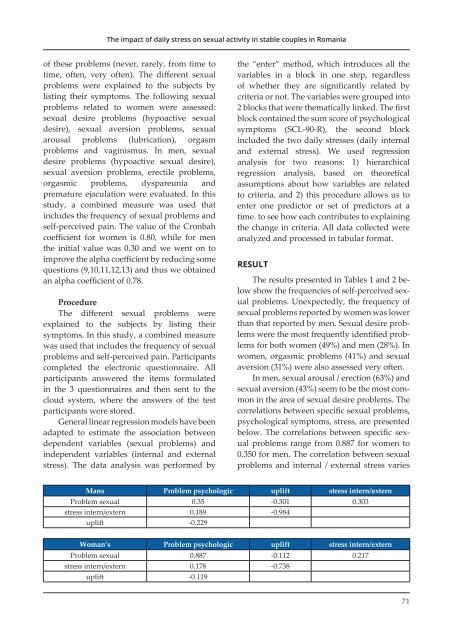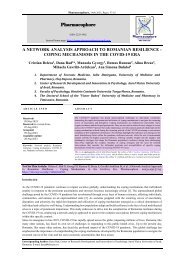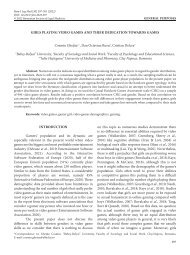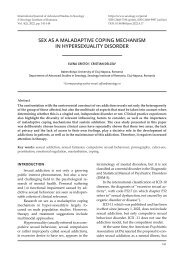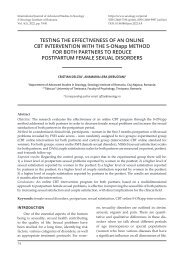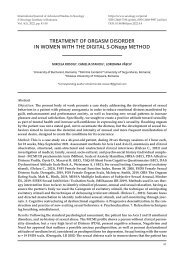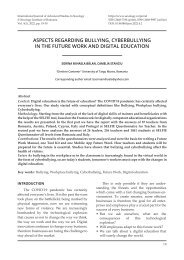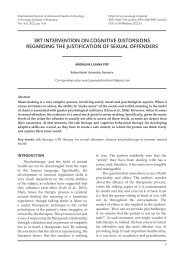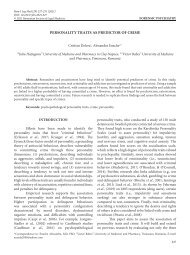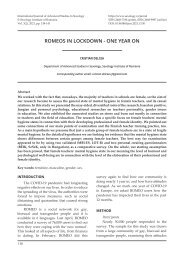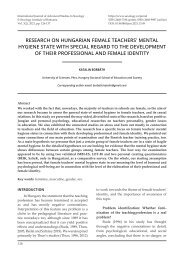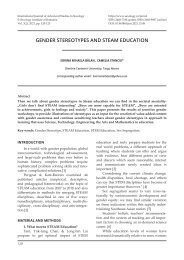THE IMPACT OF DAILY STRESS ON SEXUAL ACTIVITY IN STABLE COUPLES IN ROMANIA
Purpose: This study addresses the issue of how stress is related to sexual problems among women and men in close relationships (we considered stable couples). Psychological symptoms, relationship quality, daily internal stress (meaning, stress that comes from the couple, such as conflicts, concern for the partner), daily external stress (meaning, stress that occurs outside the couple, such as stress at work, stressful relatives and so on) were examined for their association with various sexual problems. Method: The study included 38 couples participating in this study, chosen at random from a sample of sexually active couples. Online questionnaires were used. Results: The results so far support the hypotheses that 1) there is an incremental effect or stress on sexual problems, controlling psychological symptoms and the quality of the relationship and that 2) it is primarily internal daily stress. Emotional stress that is related to sexual problems, especially hypoactive sexual desire in women and men, sexual aversion in women, vaginismus in women and premature ejaculation in men. Conclusions: Our findings indicate that the treatment of these sexual problems should address relationship issues, including a focus on helping individuals to improve their stress management skills in their relationship. Inner stress plays a key role in sexual behavior, this study once again highlights the fact that better communication as a couple, relaxation and finding specific copying methods are a good remedy, but more studies are needed to demonstrate effectiveness. them.
Purpose: This study addresses the issue of how stress is related to sexual problems among women and
men in close relationships (we considered stable couples). Psychological symptoms, relationship quality,
daily internal stress (meaning, stress that comes from the couple, such as conflicts, concern for the partner),
daily external stress (meaning, stress that occurs outside the couple, such as stress at work, stressful
relatives and so on) were examined for their association with various sexual problems.
Method: The study included 38 couples participating in this study, chosen at random from a sample of sexually active couples. Online questionnaires were used.
Results: The results so far support the hypotheses that 1) there is an incremental effect or stress on sexual
problems, controlling psychological symptoms and the quality of the relationship and that 2) it is primarily
internal daily stress. Emotional stress that is related to sexual problems, especially hypoactive sexual
desire in women and men, sexual aversion in women, vaginismus in women and premature ejaculation
in men.
Conclusions: Our findings indicate that the treatment of these sexual problems should address relationship
issues, including a focus on helping individuals to improve their stress management skills in their
relationship. Inner stress plays a key role in sexual behavior, this study once again highlights the fact that better communication as a couple, relaxation and finding specific copying methods are a good remedy, but more studies are needed to demonstrate effectiveness. them.
Create successful ePaper yourself
Turn your PDF publications into a flip-book with our unique Google optimized e-Paper software.
The impact of daily stress on sexual activity in stable couples in Romania<br />
of these problems (never, rarely, from time to<br />
time, often, very often). The different sexual<br />
problems were explained to the subjects by<br />
listing their symptoms. The following sexual<br />
problems related to women were assessed:<br />
sexual desire problems (hypoactive sexual<br />
desire), sexual aversion problems, sexual<br />
arousal problems (lubrication), orgasm<br />
problems and vaginismus. In men, sexual<br />
desire problems (hypoactive sexual desire),<br />
sexual aversion problems, erectile problems,<br />
orgasmic problems, dyspareunia and<br />
premature ejaculation were evaluated. In this<br />
study, a combined measure was used that<br />
includes the frequency of sexual problems and<br />
self-perceived pain. The value of the Cronbah<br />
coefficient for women is 0.80, while for men<br />
the initial value was 0.30 and we went on to<br />
improve the alpha coefficient by reducing some<br />
questions (9,10,11,12,13) and thus we obtained<br />
an alpha coefficient of 0.78.<br />
Procedure<br />
The different sexual problems were<br />
explained to the subjects by listing their<br />
symptoms. In this study, a combined measure<br />
was used that includes the frequency of sexual<br />
problems and self-perceived pain. Participants<br />
completed the electronic questionnaire. All<br />
participants answered the items formulated<br />
in the 3 questionnaires and then sent to the<br />
cloud system, where the answers of the test<br />
participants were stored.<br />
General linear regression models have been<br />
adapted to estimate the association between<br />
dependent variables (sexual problems) and<br />
independent variables (internal and external<br />
stress). The data analysis was performed by<br />
the “enter” method, which introduces all the<br />
variables in a block in one step, regardless<br />
of whether they are significantly related by<br />
criteria or not. The variables were grouped into<br />
2 blocks that were thematically linked. The first<br />
block contained the sum score of psychological<br />
symptoms (SCL-90-R), the second block<br />
included the two daily stresses (daily internal<br />
and external stress). We used regression<br />
analysis for two reasons: 1) hierarchical<br />
regression analysis, based on theoretical<br />
assumptions about how variables are related<br />
to criteria, and 2) this procedure allows us to<br />
enter one predictor or set of predictors at a<br />
time. to see how each contributes to explaining<br />
the change in criteria. All data collected were<br />
analyzed and processed in tabular format.<br />
RESULT<br />
The results presented in Tables 1 and 2 below<br />
show the frequencies of self-perceived sexual<br />
problems. Unexpectedly, the frequency of<br />
sexual problems reported by women was lower<br />
than that reported by men. Sexual desire problems<br />
were the most frequently identified problems<br />
for both women (49%) and men (28%). In<br />
women, orgasmic problems (41%) and sexual<br />
aversion (31%) were also assessed very often.<br />
In men, sexual arousal / erection (63%) and<br />
sexual aversion (43%) seem to be the most common<br />
in the area of sexual desire problems. The<br />
correlations between specific sexual problems,<br />
psychological symptoms, stress, are presented<br />
below. The correlations between specific sexual<br />
problems range from 0.887 for women to<br />
0.350 for men. The correlation between sexual<br />
problems and internal / external stress varies<br />
Mans Problem psychologic uplift stress intern/extern<br />
Problem sexual 0.35 -0.301 0.303<br />
stress intern/extern 0.189 -0.984<br />
uplift -0.229<br />
Woman’s Problem psychologic uplift stress intern/extern<br />
Problem sexual 0.887 -0.112 0.217<br />
stress intern/extern 0.178 -0.738<br />
uplift -0.119<br />
71


